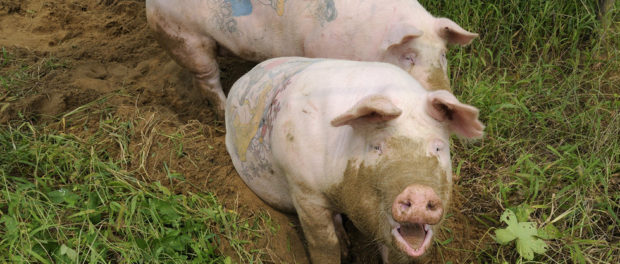Wim Delvoye: Twisting and Ornamenting Quotidian Objects and Symbols
Written by Stephanie Gagné
Tires, crucifixes, tattoos, gothic ornamentation and pigskin – these are the various eclectic materials and objects used by Belgium artist, Wim Delvoye (b. 1965), in the current exhibition Wim Delvoye at the DHC/Art Foundation for Contemporary Art. Called the enfant terrible or provocateur of the art world, Delvoye seeks to shock his audience through the materiality and techniques of his conceptual practice, while examining and criticizing issues of class, economy, technology, brands and consumerism.
The exhibition is organized thematically with Delvoye’s older and more recent artworks of his computer designed sculptures and traditional craftsmanship. Wim Delvoye is centered on the artist’s de-contextualization of quotidian objects, symbols and icons by repurposing them from their original context in order to reconsiders binary relationships between high art and popular culture, the traditional and the contemporary, the use and the value. Through his artistic techniques of twisting and ornamentation, Delvoye both criticizes and diffuses these relationships.

twisted-tyres. Wim Delvoye
Delvoye utilizes a democratized object, the tire, of both the bicycle and the car on the second floor gallery. His Twisted Tyres series (2013), consisting of bicycle tires placed on pedestals, are mathematically reformed as they are twisted into a Mobiüs puzzle, rendering the wheels functionless. Parallel is his Carved Tyres series (2011), comprising of five car tires placed upwards on a pedestal, which are each engraved with different intricate patterns based from various cultural aesthetics; effectively, he elevates the democratized wheel into a beautiful sculpture.
The third floor reveals Delvoye’s renowned tattooed pig hide, All American Girl (2005-6), in which three skins are stretched out and framed against the wall (a faint smell of animal hide perfumes the nearby area space). Appropriated images of brands, as well as religious and cultural iconography (Ganesh and the American eagle), are ornamented on the backs of piglets*, which are in themselves, contentious symbols of filth, indulgence, and wealth; Delvoye is questioning the use and value of these familiar symbols. Additionally, he plays with the idea of ‘live art’ as he sold the piglets to collectors and lived in his farm until their death. Sequentially, the basement floor of the gallery displays Art Farm (2012), a three-channel video installation, which exposes eight days of the tattooed pigs in Delvoye’s farm.

Wim Delvoye. Art Farm. Angel Dust Belfry cultural centre. Bruges.
In the second building of DHC/Art, the binary of the traditional and the contemporary, is evident through his stylistic construction of metals. Untitled (Maserati) (2012) is an exterior body of a 1961 Maserati, created with aluminum and embossed with Islamic calligraphy and motifs by Iranian artisans, which tells the story about a man travelling around the world by horse. In the other gallery room, three large gothic styled sculptures sit on pedestals. One of the sculptures, Twisted Dump Truck Clockwise (2011), is a complexly detailed truck while simultaneously appearing as a gothic cathedral through laser cutting steel, twisted in a dramatic Disney-like fashion. In these gallery spaces, Delvoye re-appropriates the traditionally religious through its aesthetics with contemporary transportation.
Wim Delvoye reveals Wim Delvoye’s artistic lineage of Marcel Duchamp and Andy Warhol as he asks the viewer to question their understanding of the form and function of objects and symbols.
*Although he was met with protests by animal-rights activists, Wim Delvoye states that he had veterinarians with him, who sedated the piglets.
DHC/Art Foundation for Contemporary Art
Wim Delvoye is at the DHC/Art Foundation for Contemporary art until March 19. For more details, click HERE.






